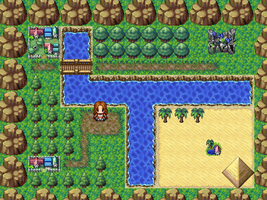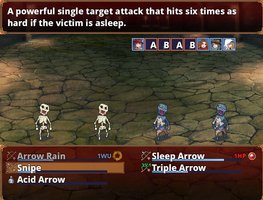Post Mortem
Veritas: Halcyon » Devlog




Hello again, friends!
Well, if you're reading this -- thanks for reading the post mortem. A few notes:
- This game took about three whole months to develop from a pre production that began in late December/early January to completion on 3/31/19.
- As opposed to my usual take of pros(things that went well) vs cons (things that did not go well), I'll be posting some key influences, and insights on my design process.
- Additionally, I'm limiting my word count per item. There's a lot that really influenced me on this game so for the sake of my own time and as an exercise in clarity, I'm limiting what I say. I'm happy to elaborate on any item if anyone wants to know more thoughts.
DESIGN INFLUENCES AND FUN THINGS.
- Zelda and Chill, every morning. This is a great playlist by Gamechops and Mikel. I listened to this every morning in development and got a lot of work done.
- The NeverEnding PreProduction. Based on a book Randy got me for Christmas and also in watching the Horizon Zero Dawn Post Mortem I learned that there are a lot of things that happen in Pre Production. I shouldn't feel bad when that process takes forever because it determines the rest of the project. That said, it's very painful because it's easy to feel like you're not getting anything done when you're working with paper, index cards, and excel sheets instead of the engine itself.
- Prototypes for content driven games. For those who know me, the idea behind all this RPG Maker MV (RMMV) work is to create a large volume of prototypes. Since my interest in games and rpg's lies in content driven games re, narrative & exploration driven, (per a GDC talk on the Fable Prototype) it's difficult to prototype and requires more because, frankly, how do you quickly prototype world building and exploration?
- Key Influence: Dragon Quest XI. I finished this game (I have an article I wrote regarding my concerns per its design) while designing and developing this one. The major influence is in the episodic narrative that introduces a story as the game introduces a character -- a very easy to follow anime-structure for stories it seems. I also stole the idea of character development via weapon specialty -- an effective way to easily give player choice and expression without running the risk that the player will ruin the game for himself later.
- Notable Narrative Points. I wrote the plot and script for Veritas: Halcyon practically as a writing exercise -- sitting down with a pad of paper and just writing whatever came out. Sloppy as that is and certainly proves to be in the loose narrative, the abstracted expression of doing that writing brought out some notable themes, that I am obviously thinking about, namely: religion vs. myth, the power of books as knowledge, the abuse of power in religion, a would-be queen of a ruined castle, cats, and beer.
- Key Influence: Memoirs of a Geisha. I read this over the three months of development. I was quite taken with the narrator-centered story telling and the obviously female heroine -- both of which obvious influences in the game.
- Key Influence: Unlimited Saga. When I started production on this game, I really wanted to create a board-game like experience similar to Unlimited Saga. I ended up scrapping that because of how it reads in game (will probably require UI element manipulation) and stealing its weapon mastery system instead.
- Key Influence: Brunswick. I'm co-owner to a cat now and I love them. There are cats all over Bast's Oasis.
- World Unveiled through NPC's. There's a comparison between Final Fantasy X vs. Final Fantasy XIIIthat addresses how effectively FFX brings the player into the world through Tidus' eyes. Tidus, like the player, is an outsider -- so it's easy to introduce him to the world and explain the world to him via cultural interactions. Without really intending to, I found myself doing that -- partially because it was an easy way to make NPC's far more interesting.
- Marketing Text. Based on the book Randy got me and the article for DQXI I wrote, I realized that I need to start identifying the USP's behind my games. That said, in some ways, they're not as hard to find as you think. Narrative alone, plus a mildly interesting character progression system is enough to make for a USP.
- WORKING WITH PAPER. Per Cal Newport's Digital Minimalism and also this GDC talk on working with paper, I've learned I love working with paper; I find it very soothing. Anything I can do away from the computer, on paper, on a table, with a pen and index cards -- I prefer working this way now if I can. It is slower, but every time I work with paper the caliber of my work -- whether mapping, narrative, or programming -- significantly improves.
MOVING FORWARD
- Narrative Structured Gameplay. The best games and stories have interesting beginnings and stories -- the game fits into the middle of all of that. I plan on experimenting with this moving forward instead of, "Hi player. This person wants you to do stuff for him."
- Key Influence: Pathfinder Adventure Card Game (PACG) and Deckbuilding. Over the course of this game, I've gotten really into PACG as well as other card games whether it be Magic: the Gathering or Shards of Infinity. Card games really influenced me a lot so I hope to see how I can incorporate their elements more. More on this below.
- Pre-Probability. Card games and board games are especially interesting when they use an idea called "Pre-probability" (coined per this chap from a GDC talk on Board Game design in video games). I'd like to incorporate more Pre-probability in my games moving forward -- where probability determines player choices and options, but then afterwards things aren't random. You don't have a chance to miss, or crit, or this attack could be an 8 or an 11 or a 17. More on this sometime.
- Pixel: WorldBuilding, Key Influence: Leonardo Da Vinci. I'm now reading Leonardo da Vinci's biography where he talks a lot about how an artist really determines the world he crafts based on his drawings. I've considered learning pixel so that I'm better able to craft said world without being limited by my assets.
- Colons are cool. Colons are fun and I use them everywhere now (thanks to 7th Dragon Code: VFD) like in Veritas; Halcyon.
- FES Sprites. I love these sprites, but the tileset is really hard to work with. I'll see if working with TileD changes my opinion of this.
THINGS I DIDN'T HAVE TIME TO IMPLEMENT OR LEARN:
- User interface manipulation. Part of making the game feel more like my own instead of an RMMV game is User Interface (UI). Part of this is not knowing where I want UI or thinking it through, and part of it is not taking the time to work with it. It's presently optimized so it's difficult to prioritize a change -- but if I ever want to have something that feels original moving forward I'll likely need to play with this.
- TileD. I suspect that learning this software will help me a lot work with just about any tileset.
- JavaScript. There's a book on javascript I'd like to read because I really want to try a few dynamic (once again per the Fable talk) game prototypes within an RPG. I think these things could make an RPG feel more skill oriented rather than the standard back and forth of a turn-based combat system:
- Randomizing Combat Options (pre-probability and deck building)
- Blitz or Magicka Inputs (player must push a series of buttons to execute)
And those are all my thoughts. Thanks for reading this far if you did. I hope you enjoyed and learned a few things and hopefully get a chance to watch or read some of the points linked above.
Except my cat, you can't have him.
Files
Halcyon.zip 818 MB
Mar 31, 2019
Get Veritas: Halcyon
Veritas: Halcyon
JRPG: a short story about myth, truth, and religion, featuring an all female cast.
| Status | Released |
| Author | debonairdandy |
| Genre | Role Playing |
| Tags | JRPG, RPG Maker |
Leave a comment
Log in with itch.io to leave a comment.